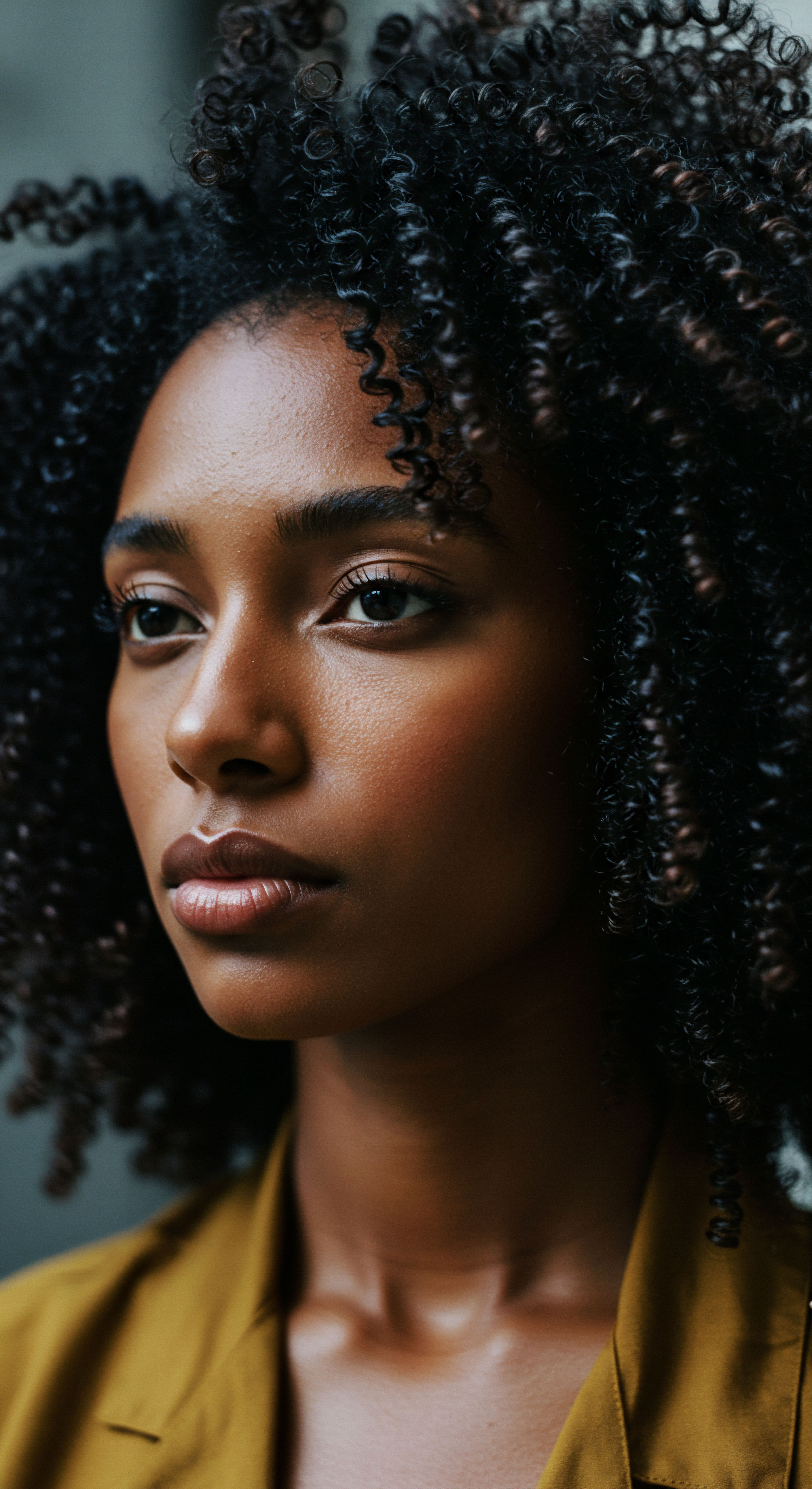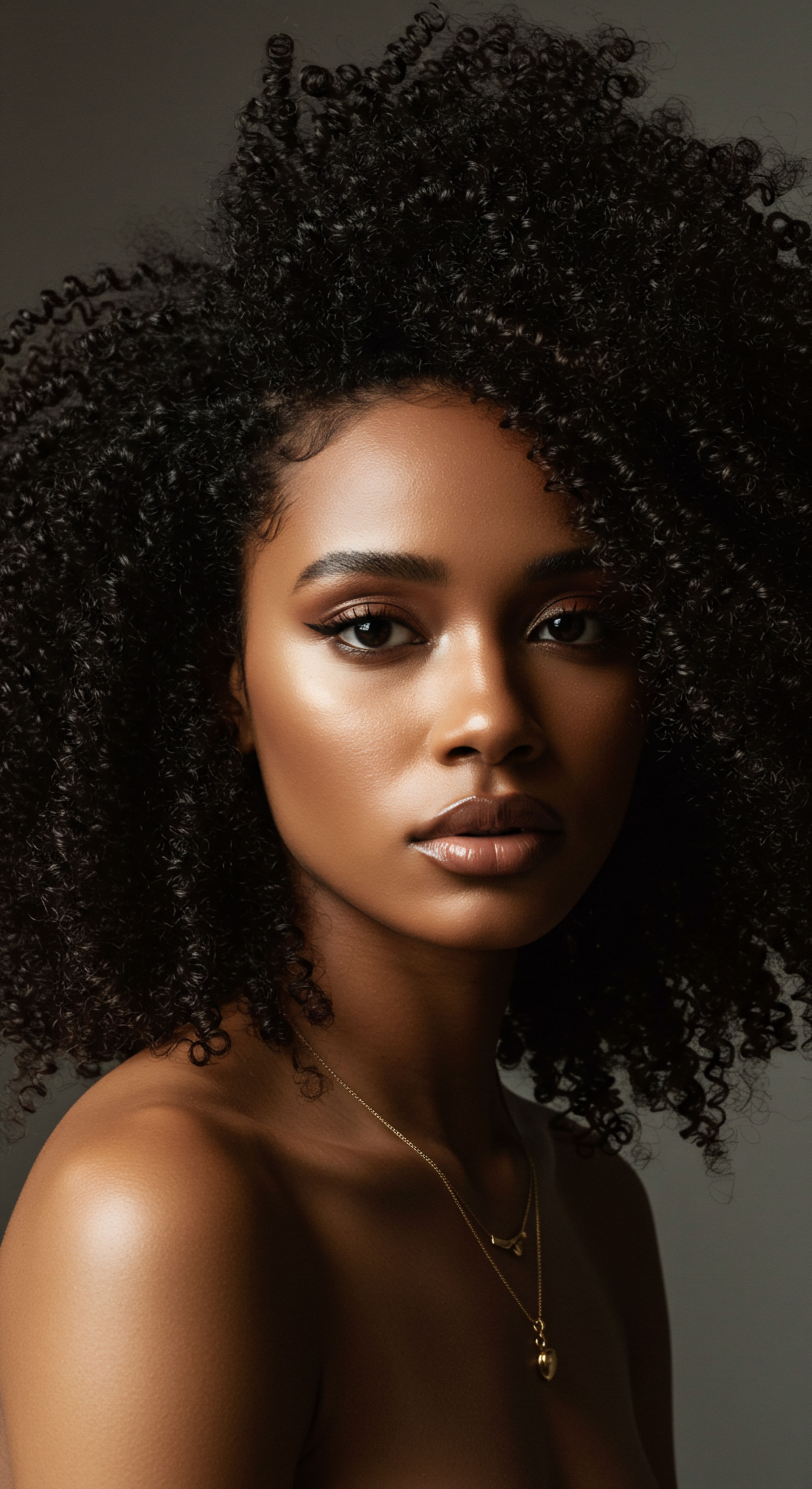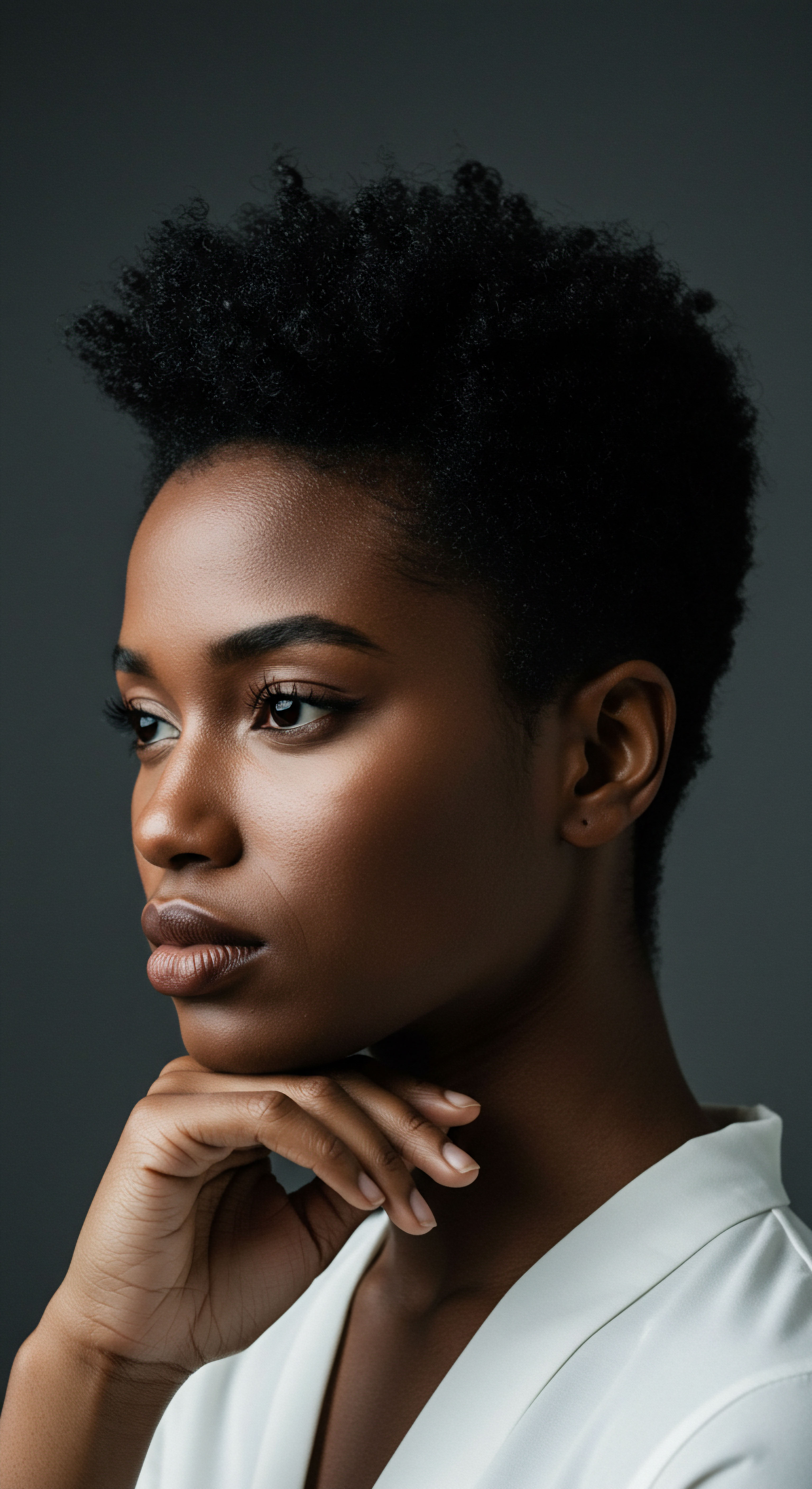
Roots
The whisper of history often carries echoes of beauty, particularly when one listens closely to the stories held within strands of hair. Our modern quest for healthy, vibrant hair often sends us searching through countless products and fleeting trends, yet a quiet wisdom reminds us that the foundations of care were laid long ago, in lands bathed by ancient suns. Consider the Nile, its banks fertile, nurturing not only life but also a profound understanding of the natural world, an understanding that extended even to the scalp.
What did those who walked its shores know about hair health, about keeping the scalp balanced and ready for growth? Their insights, recorded on papyrus and preserved in tomb art, speak of a deep connection to the earth’s bounty, a reverence for the elements that sustained their very being.
The arid climate of ancient Egypt presented a formidable challenge to maintaining moisture and vitality in hair. The relentless sun and pervasive sand demanded solutions that protected, soothed, and nourished. Far from mere aesthetic pursuits, their practices were rooted in a practical necessity for comfort and well-being. The ingredients they turned to were those readily available from their environment ❉ rich oils pressed from native plants, animal fats collected and refined, and minerals from the earth itself.
These components formed the bedrock of their scalp care regimens, designed to combat dryness, promote growth, and ward off common ailments. Their methods, though seemingly simple to our contemporary eyes, reveal a sophisticated observational knowledge of how natural substances interacted with the body.
Ancient Egyptian scalp care, born from environmental necessity, relied on local plant oils, animal fats, and earth minerals.

Plant Based Oils and Resins
Among the most frequently employed ingredients for scalp care were various plant-derived oils. These were valued for their emollient properties, capable of softening the scalp and providing a protective barrier against the harsh desert air. Almond Oil, derived from the kernels of the almond tree, was a particular favorite.
Its light texture and conditioning abilities made it suitable for regular application, helping to maintain suppleness and a healthy sheen. Records suggest its use extended beyond mere cosmetic application, serving as a foundational component in many ancient formulations aimed at overall hair health.
Another prominent oil was Castor Oil. Known for its thicker consistency, this oil was believed to possess properties that encouraged hair growth and fortified strands. Its rich fatty acid profile would have provided substantial nourishment to the scalp, creating an environment conducive to healthy hair.
Ancient Egyptians likely applied it with a gentle massage, working it into the scalp to stimulate circulation and aid absorption. This practice parallels modern hair oiling traditions seen in many cultures today, underscoring the enduring wisdom of these early applications.
Beyond these widely recognized oils, other plant extracts also found their way into scalp preparations. Moringa Oil, often referred to as the “miracle oil,” was esteemed for its antioxidant content and lightweight feel, contributing to scalp nourishment and hair vitality. Papyrus Seed Oil, derived from the iconic plant of the Nile, also offered hydration and a smooth finish, suggesting a comprehensive understanding of plant benefits.
Resins, such as Frankincense and Myrrh, while more commonly associated with perfumes and spiritual rituals, sometimes appeared in scalp concoctions, likely for their aromatic qualities and perceived purifying attributes. These ingredients speak to a system of care that transcended simple physical needs, touching upon sensory and spiritual well-being.

Animal Fats and Their Utility
Animal fats constituted a significant category of ingredients in ancient Egyptian scalp care. Their unctuous nature made them ideal carriers for other substances, providing a rich base for salves and ointments. These fats offered intense moisture and were instrumental in styling, particularly for wigs and hair extensions, which were common.
Beeswax, a natural product from bees, served a similar purpose, offering structural hold and a protective coating. Its ability to set hair and provide a lustrous appearance made it invaluable for elaborate coiffures, even extending to funerary preparations where hairstyles were meticulously preserved for the afterlife.
The range of animal fats employed was quite diverse, reflecting a pragmatic use of available resources. Evidence from archaeological findings and ancient texts points to the use of fats from various creatures. These included more common sources, as well as those that might seem unconventional to contemporary sensibilities.
The utility of these fats stemmed from their ability to form a thick, protective layer, helping to seal in moisture and protect the scalp from the elements. This protective quality was paramount in the desert environment, where extreme dryness could quickly lead to scalp irritation and hair fragility.
The application of these fats often involved blending them with other ingredients to create a more potent or palatable mixture. The sheer variety underscores a culture that meticulously experimented with natural materials to achieve desired cosmetic and therapeutic outcomes.
| Ingredient Category Plant Oils |
| Specific Examples Almond oil, Castor oil, Moringa oil, Papyrus seed oil |
| Perceived Benefit Hydration, conditioning, growth stimulation, shine |
| Ingredient Category Animal Fats |
| Specific Examples Beeswax, various animal fats |
| Perceived Benefit Styling, preservation, deep moisture, protection |
| Ingredient Category Herbs & Botanicals |
| Specific Examples Henna, Fenugreek seeds, Aloe vera |
| Perceived Benefit Coloring, strengthening, soothing, growth promotion |
| Ingredient Category Minerals & Other |
| Specific Examples Honey, Salt, Ochre |
| Perceived Benefit Moisture retention, exfoliation, cleansing |

Earth Minerals and Botanical Extracts
The earth itself provided a wealth of ingredients for ancient Egyptian scalp care. Minerals, often finely ground, were incorporated for their various properties. While perhaps more widely known for their use in eye makeup, minerals such as Red Ochre and even forms of lead sulfide (galena) were sometimes part of broader cosmetic formulations, which might have indirectly influenced scalp health through their presence in ointments or salves applied to the skin around the hairline. The precise application for scalp-specific treatments, however, leaned more towards plant-based solutions.
Botanical extracts extended beyond oils. Henna, derived from the Lawsonia plant, was a powerful and versatile ingredient. Primarily recognized as a natural dye for hair and nails, it also possessed conditioning properties.
Ancient Egyptians used henna to color grey hair, enhance natural hair tones, and provide a reddish tint. Beyond its aesthetic appeal, henna was believed to strengthen hair and soothe the scalp, potentially helping with conditions like dandruff due to its cooling qualities.
Other plant components, such as Fenugreek Seeds, were valued for their purported ability to stimulate hair growth, a belief that persists in some traditional practices today. Aloe Vera, known as the “plant of immortality,” was prized for its soothing and hydrating properties, offering relief to irritated scalps and promoting overall health. These ingredients, combined with natural sweeteners like Honey, which offered humectant and antimicrobial benefits, demonstrate a holistic approach to scalp health that integrated elements from the plant and animal kingdoms.

Ritual
To stand on the banks of the Nile, gazing at the sun-drenched landscape, is to sense the deep rhythms of ancient life. The ingredients themselves, whether pressed from a seed or rendered from fat, held meaning. Yet, it was in the ritual of their application that these substances truly came alive, transforming simple materials into acts of profound self-care.
This is where the wisdom of the ancients truly resonates, moving beyond mere components to reveal the deliberate, thoughtful practices that shaped their hair and scalp well-being. What can these ancient practices tell us about a purposeful approach to scalp health today?
The ancient Egyptians approached personal care with a sense of ceremony, recognizing the connection between external appearance and inner vitality. Their daily routines were often intertwined with beliefs about purity, protection, and status. Scalp care, therefore, was not a hurried affair but a measured process involving careful preparation and application.
This thoughtful engagement with their bodies, and specifically their hair and scalp, speaks to a culture that understood beauty as an extension of one’s holistic state. The tools they employed, though rudimentary by modern standards, were crafted with precision and served as extensions of their hands in these delicate procedures.

Preparation and Application Methods
The raw ingredients gathered from the land required careful preparation before they could grace the scalp. Plant materials, like henna leaves or fenugreek seeds, were often dried and ground into fine powders. These powders were then mixed with liquids, typically water or various oils, to form a paste or a more liquid concoction.
For instance, Henna Powder would be combined with warm water, or sometimes tea or yogurt, to create a smooth paste, occasionally with an added tablespoon of olive or coconut oil for enhanced moisture. This paste was then applied evenly to clean, damp hair, often covered with a cap, and left for several hours before rinsing thoroughly.
Animal fats, too, underwent processes to make them suitable for topical use. They were likely rendered to purify them, then combined with other ingredients to create ointments or balms. The Papyrus Ebers, a medical text dating to around 1550 BCE, provides glimpses into some of these preparations.
One notable remedy for hair growth involved grinding a Donkey’s Tooth in honey and rubbing this unusual ointment onto the scalp. Such recipes, while startling to our contemporary understanding, underscore the experimental and resourceful nature of ancient Egyptian medical and cosmetic practices.
Ancient Egyptian scalp treatments, from plant pastes to animal fat concoctions, were applied with deliberate, purposeful intent.
Application was often performed with simple tools or the hands themselves. Combs, some exquisitely crafted from ivory or fish bones, were used not only for detangling but also for distributing oils and treatments evenly through the hair and across the scalp. This methodical approach ensured that the beneficial properties of the ingredients reached the entire scalp surface, allowing for maximum absorption and effect. The act of massaging the scalp, a practice still advocated today for stimulating blood flow, was likely an intuitive part of their routine, contributing to the perceived efficacy of their treatments.

Wigs and Scalp Protection
Wigs played a central role in ancient Egyptian society, serving as symbols of status, protection, and hygiene. Both men and women, across all social strata, wore wigs, often shaving their natural hair short or completely to accommodate them. This practice offered significant protection to the scalp from the intense sun and, importantly, helped in preventing and managing lice infestations, a common concern in ancient times.
The care of these wigs was as meticulous as the care of natural hair. Wigs, made from human hair, sheep’s wool, or plant fibers, were regularly treated with emollients and oils derived from vegetables or animal fats. These fatty substances, including Beeswax and other animal fats, were used to set elaborate styles, provide sheen, and prolong the wig’s life.
The remarkable preservation of some ancient wigs, such as the one found in the tomb of Nauny, a priestess from around 1000 BCE, provides tangible evidence of these practices. Her wig, made of human hair plaits, was treated with beeswax and covered with a layer of animal fat, maintaining its appearance for millennia.
The use of wigs meant that the natural scalp, though often covered, still required attention. Regular washing of the natural hair, even if kept short, was a routine practice, although the frequency remains unknown. The underlying principle remained consistent ❉ a healthy scalp was the foundation for healthy hair, whether natural or augmented by a wig. The meticulous grooming of wigs, often involving scented petals or wood chips like cinnamon, further underscores the Egyptian commitment to cleanliness and pleasant aroma, extending their care rituals beyond purely medicinal concerns.
- Hair Washing ❉ Egyptians regularly washed their natural hair, even when worn under wigs, though specific cleansing agents are less documented than treatments.
- Combs ❉ Used for detangling, styling, and applying oils and treatments evenly across the scalp and hair.
- Fat-Based Gels ❉ Employed to hold intricate hairstyles in place, demonstrating a functional cosmetic application.

Relay
To truly comprehend the ingenuity of ancient Egyptian scalp care, one must look beyond the individual ingredients and consider the interconnectedness of their practices, beliefs, and scientific observations. The arid desert climate, the prevalence of certain ailments, and a deep spiritual connection to nature all shaped their approach. Their remedies, some remarkably insightful, others startlingly unconventional, paint a picture of a society grappling with the human condition, including the universal concern of hair health. What deeper meanings did hair hold for them, and how did their quest for solutions reflect their understanding of the body and the world?
The medical papyri, such as the Ebers Papyrus and the Hearst Papyrus, stand as testaments to their organized medical knowledge, recording hundreds of prescriptions for various conditions, including those related to hair and scalp. These texts reveal not only the ingredients but also the specific ailments they aimed to address, such as hair loss, greying, and scalp irritations. The integration of practical observation with what we might now term “folk remedies” or “magical thinking” was characteristic of their holistic approach, where physical well-being was inextricably linked to spiritual harmony. This confluence of pragmatic application and symbolic significance lends a profound depth to their cosmetic and medicinal practices.

Ancient Formulations and Modern Scrutiny
Many ancient Egyptian scalp remedies were multi-ingredient formulations, blending plant, animal, and mineral components. For promoting hair growth, a variety of animal fats were often combined. The Ebers Papyrus, a crucial source, details a concoction for baldness that includes a mixture of fats from a Hippopotamus, a Crocodile, a Tomcat, a Snake, and an Ibex.
This mixture would be applied to the scalp, sometimes after being heated. Another suggested remedy involved porcupine hair boiled in water and applied for four days, or even the leg of a female greyhound sautéed in oil with the hoof of a donkey.
These animal-derived ingredients, while seemingly bizarre to a modern audience, reflect a profound belief in the transference of qualities. The strength or vitality of the animal was thought to imbue the remedy with its desired effect on hair growth. While contemporary science may not support the direct efficacy of such ingredients for hair regrowth, their consistent mention across various texts suggests a widespread, albeit perhaps psychologically effective, practice. The inclusion of these components highlights a different scientific paradigm, one rooted in sympathetic magic and empirical observation rather than controlled trials.
A striking example of this blend of practical application and symbolic belief can be seen in remedies for greying hair. Some texts suggest applying the blood of a black ox or calf boiled in oil to transfer the animal’s dark color to the hair, or using the horn of a gazelle mixed with warm oil to prevent grey hairs. Such practices speak to a desire to maintain a youthful appearance, linking it to the vitality of the animal world.
The Ebers Papyrus reveals surprising ancient Egyptian remedies for hair loss, including mixtures of fats from various animals, reflecting a distinct historical understanding of healing.

Hair Preservation and Archaeological Evidence
Beyond daily care, the ancient Egyptians displayed a remarkable concern for hair preservation, extending even into the afterlife. Recent archaeological and scientific analyses of mummified remains have provided tangible evidence of their advanced hair styling and preservation techniques. A study published in the Journal of Archaeological Science in 2011 analyzed hair samples from 18 mummies, some naturally preserved and others artificially mummified, dating back as far as 3,500 years ago.
The researchers discovered that nine of these mummies had their hair coated in a mysterious, fat-like substance. Chemical analysis, specifically gas chromatography–mass spectrometry, identified this coating as containing biological long-chain fatty acids, including palmitic acid and stearic acid. This indicates the use of a Fat-Based “gel” or styling product. The presence of this substance on both naturally and artificially mummified individuals suggests it was a beauty product used in life as well as a deliberate part of the mummification process to preserve hairstyles.
This finding is particularly compelling because it demonstrates that ancient Egyptians not only used these ingredients for immediate care but also for long-term preservation, highlighting the profound cultural significance of hair. The meticulous effort to maintain a deceased individual’s hairstyle into eternity underscores the importance of personal appearance and individuality even after death. It provides a unique data point ❉ the discovery of actual hair gel, made of animal and plant fats, on mummified remains, confirming that ancient Egyptians had sophisticated styling products that have endured for millennia.
The longevity of these fatty acid compounds on ancient hair offers a rare glimpse into the stability of these natural formulations and their effectiveness in a dry environment. It also poses questions about the exact “recipe” of these ancient gels, suggesting a complex blend of fats, possibly mixed with resins or other plant extracts to achieve specific textures and holds. This tangible evidence bridges the gap between textual descriptions and physical reality, offering a deeper appreciation for their chemical and cosmetic knowledge.
- Mummy Hair Analysis ❉ Scientific studies of ancient Egyptian mummies reveal the persistent use of fat-based products for hair styling and preservation.
- Fatty Acid Compounds ❉ Gas chromatography–mass spectrometry identifies long-chain fatty acids like palmitic and stearic acids in mummy hair coatings.
- Preservation Intent ❉ The presence of these substances on both naturally and artificially mummified hair indicates their dual purpose in life and death.

Cultural Context and Practicality
The ancient Egyptian approach to scalp care was deeply interwoven with their broader cultural and social structures. Hair was not merely an appendage; it was a symbol of status, beauty, and even spiritual connection. Priests, for instance, often shaved their heads for ritual purity, a practice that also served the practical purpose of preventing lice. Conversely, elaborate wigs and styled natural hair were indicators of wealth and social standing, necessitating a range of care products and techniques.
The emphasis on cleanliness was also a practical response to the hot climate. Daily bathing was common, and while evidence for soap is limited, mixtures of animal and vegetable oils with alkaline salts were likely used for cleansing the body and possibly the hair. This suggests a foundational understanding of how fats and alkalis could interact to remove impurities.
The medical papyri, while containing some remedies that appear unusual today, also include treatments that reflect a pragmatic understanding of common ailments. For instance, some recipes aimed at removing unwanted hair, using mixtures that included honey and sugar, a method remarkably similar to modern sugaring. This blending of the seemingly magical with the undeniably practical underscores the comprehensive nature of their approach to body care. The meticulous record-keeping in these papyri, even for seemingly simple cosmetic applications, points to a society that valued documented knowledge and the transmission of effective practices across generations.
| Application Type Hair Growth Remedies |
| Primary Function Stimulating hair follicles, perceived vitality transfer |
| Supporting Ingredients Animal fats (lion, hippo, crocodile, snake, ibex, cat), porcupine hair, donkey's tooth, honey |
| Application Type Hair Coloring/Strengthening |
| Primary Function Masking grey hair, enhancing natural tones, conditioning |
| Supporting Ingredients Henna, blood of black ox/calf, gazelle horn |
| Application Type Styling & Preservation |
| Primary Function Holding hairstyles, protecting from elements, funerary preservation |
| Supporting Ingredients Beeswax, various animal fats (long-chain fatty acids) |
| Application Type Soothing & Hydration |
| Primary Function Alleviating scalp irritation, moisturizing dry skin |
| Supporting Ingredients Aloe vera, Almond oil, Castor oil |
| Application Type These applications highlight the diverse roles of natural ingredients in ancient Egyptian scalp health and aesthetics. |

Reflection
As we gaze back through the veil of millennia, the echoes of ancient Egyptian scalp care practices reach us not as quaint historical footnotes, but as profound reminders of humanity’s enduring connection to the earth and its offerings. Their methods, a blend of observed efficacy, symbolic belief, and practical necessity, offer a rich counterpoint to our contemporary routines. The dedication to preserving beauty and health, even beyond life itself, speaks to a timeless human desire for well-being.
Perhaps the most compelling lesson from these ancient custodians of hair wisdom lies not in mimicking their exact recipes, but in rekindling a mindful approach to our own care, drawing from nature’s gifts with respect and curiosity. What forgotten wisdom might still lie waiting to be rediscovered in the natural world around us, if only we take the time to truly see?

References
- Bryan, C. P. (1930). The Papyrus Ebers. Geoffrey Bles.
- Cox, J. (2002). The construction of an ancient Egyptian wig (c. 1400 b.c.). Ostracon J. Egypt. Study Soc., 13, 2–8.
- David, A. R. & Archbold, P. Z. (2008). Egyptian Mummies and Modern Science. Cambridge University Press.
- Ead, H. A. (n.d.). Cosmetics in Ancient Egypt. Alchemy Website.
- Grapow, H. & Westendorf, W. (1958). Grundriss der Medizin der Alten Ägypter V ❉ Die Medizinischen Texte in Hieroglyphischer Umschreibung. Akademie-Verlag.
- Kandil, H. A. & Salama, M. E. (2018). Role of the Hair in Ancient Egypt. International Journal of Tourism and Hospitality Management, 1(1), 77-84.
- Majno, G. (1975). The Healing Hand ❉ Man and Wound in the Ancient World. Harvard University Press.
- McCreesh, N. et al. (2011). Ancient Egyptian hair gel ❉ New insight into ancient Egyptian mummification procedures through chemical analysis. Journal of Archaeological Science, 38(11), 2871-2877.
- Nunn, J. F. (1996). Ancient Egyptian Medicine. British Museum Press.
- Ritner, R. K. (1993). The Mechanics of Ancient Egyptian Magical Practice. Oriental Institute of the University of Chicago.
- Zucconi, L. (2007). Ancient Egyptian Medicine ❉ A Guide to the Ancient Egyptian Medical Texts. University of Chicago Press.